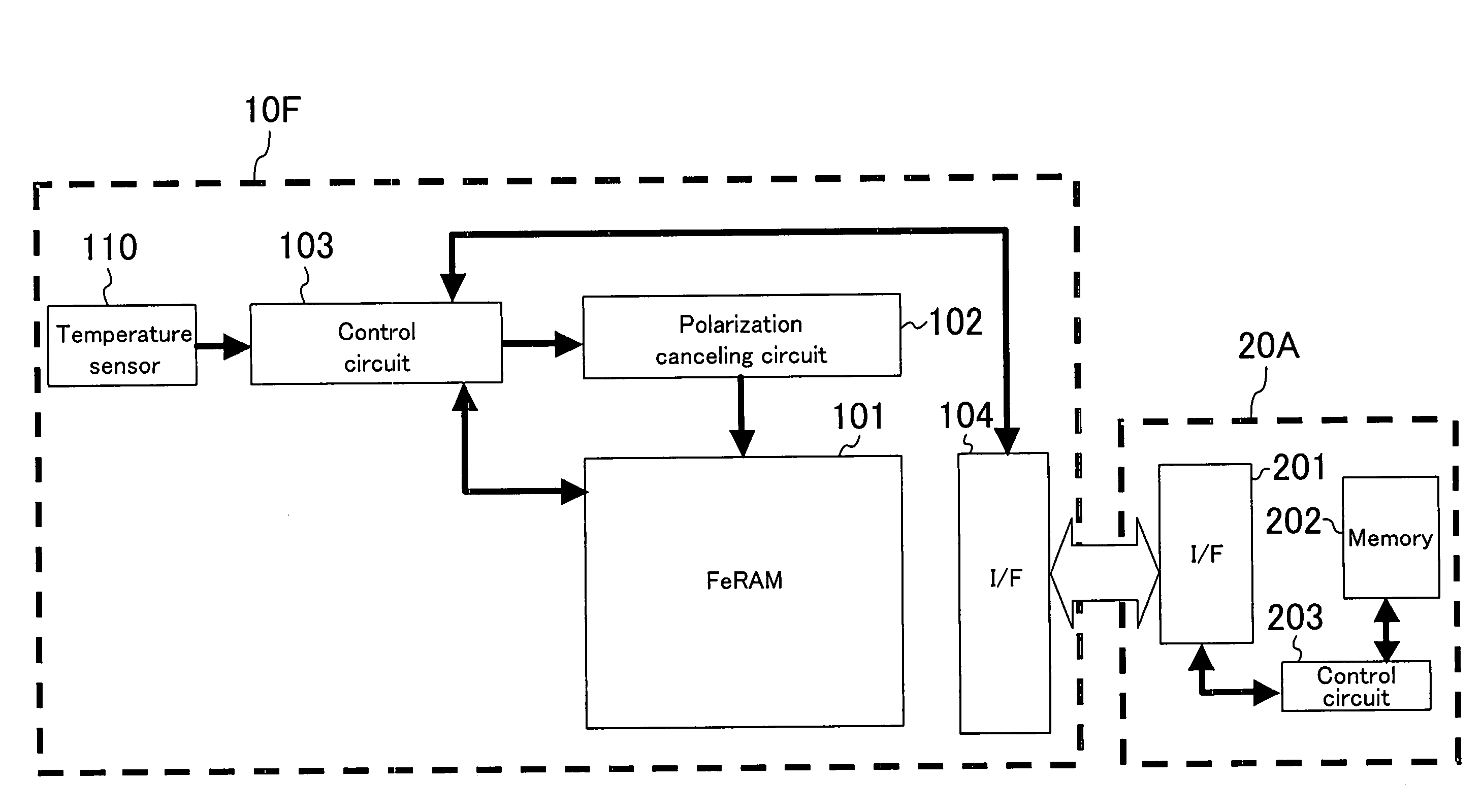Data carrier system and data saving/restoring method thereof
a data carrier and data technology, applied in the field of data carrier systems, can solve problems such as data loss in ferroelectric memory, and achieve the effects of eliminating risk, preventing data loss, and reducing the number of data storage devices
- Summary
- Abstract
- Description
- Claims
- Application Information
AI Technical Summary
Benefits of technology
Problems solved by technology
Method used
Image
Examples
first embodiment
[0048]FIG. 1 illustrates the configuration of a data carrier system according to a first embodiment. The data carrier system of this embodiment is composed of a data carrier 10A and a reader / writer 20A. The data carrier 10A includes a ferroelectric memory (FeRAM) 101, a polarization canceling circuit 102 for canceling polarization of the ferroelectric memory 101, a control circuit 103 for making data access to the ferroelectric memory 101 and controlling the operation of the polarization canceling circuit 102, and a communication interface (I / F) 104 for communicating with the reader / writer 20A. The reader / writer 20A includes a communication interface (I / F) 201 for communicating with the data carrier 10A, a memory 202, and a control circuit 203 for making data access to the memory 202.
[0049]The data carrier system of this embodiment operates in the following manner. Before the data carrier 10A is treated in a high temperature treatment process, the reader / writer 20A gives an instruct...
second embodiment
[0056]FIG. 3 illustrates the configuration of a data carrier system according to a second embodiment. The data carrier system of this embodiment is composed of a data carrier 10B and a reader / writer 20B. The data carrier 10B is obtained by adding a memory 105, which is other than a ferroelectric memory, to the data carrier 10A shown in FIG. 1. The reader / writer 20B is obtained by omitting the memory 202 and the control circuit 203 from the reader / writer 20A shown in FIG. 1.
[0057]The data carrier system of this embodiment saves data stored in a ferroelectric memory 101 to the memory 105 inside the data carrier 10B. As the memory 105, an EEPROM, a flash memory, a CMOS non-volatile memory, or the like may be used. Furthermore, if power is supplied to the data carrier 10B in high temperature treatment process, an SRAM, a register, or the like may also be used as the memory 105. Although the data retention characteristics of these types of memories deteriorate in high temperature environ...
third embodiment
[0062]FIG. 4 illustrates the configuration of a data carrier system according to a third embodiment. The data carrier system of this embodiment is composed of a data carrier 10C and a reader / writer 20B. The data carrier 10C is obtained by adding a memory switching circuit 106 to the data carrier 10B shown in FIG. 3. The reader / writer 20B is the same as that shown in FIG. 3.
[0063]The memory switching circuit 106 switches between a ferroelectric memory 101 and a memory 105 as the main memory in the data carrier 10C. That is, data access is made to either the ferroelectric memory 101 or the memory 105 selected by the memory switching circuit 106.
[0064]Specifically, the memory switching circuit 106 selects the ferroelectric memory 101 as the main memory before polarization of the ferroelectric memory 101 is cancelled, and switches to the memory 105 after the polarization cancellation. Therefore, when data communications with the reader / writer 20B are carried out in a high temperature tr...
PUM
 Login to View More
Login to View More Abstract
Description
Claims
Application Information
 Login to View More
Login to View More - R&D
- Intellectual Property
- Life Sciences
- Materials
- Tech Scout
- Unparalleled Data Quality
- Higher Quality Content
- 60% Fewer Hallucinations
Browse by: Latest US Patents, China's latest patents, Technical Efficacy Thesaurus, Application Domain, Technology Topic, Popular Technical Reports.
© 2025 PatSnap. All rights reserved.Legal|Privacy policy|Modern Slavery Act Transparency Statement|Sitemap|About US| Contact US: help@patsnap.com



